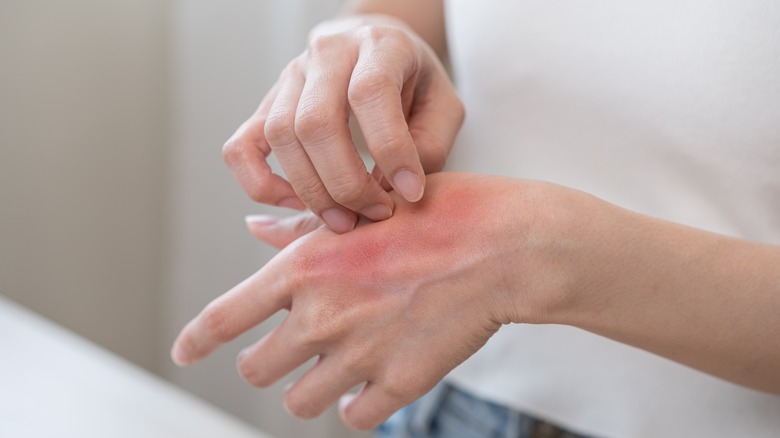If You Have A Latex Allergy, You're Probably Allergic To One Common Houseplant
While there are plenty of great houseplants for people with allergies (like the areca palm and peace lily), bold and beautiful bromeliads (Bromeliaceae) may not be one of them. With over 3,000 unique species, spanning from the pineapple plant to the bright and colorful Guzmania, bromeliads often tempt plant lovers, but they come with numerous downsides. For one, this flowering plant is known to attract mosquitos. For another, people with a latex allergy may experience allergic reactions after coming into contact with this common houseplant.
While bromeliads are generally safe and non-toxic to both humans and animals, touching their leaves and sap can cause contact dermatitis, leading to itching, redness, and overall skin discomfort in some individuals. While further studies are needed to determine how different folks react to the many types of bromeliads, it is known that some varieties can trigger symptoms that mimic those caused by a latex allergy. Most often that's because multiple plants from the bromeliads family, including the pineapple, contain a protein called bromelain, which the body can mistake for latex. This, in turn, can lead to what is called latex-fruit syndrome. Essentially, someone allergic to latex who touches the plant will experience an allergic reaction, ranging from itching to hives, just as they would if they had come in contact with the synthetic substance. While only 30 to 50% of people with latex allergies experience this phenomenon, it is certainly worth considering before bringing home a bromeliad.
Bromeliads may not be suited for individuals with a latex allergy
Phytodermatitis or plant dermatitis is a fairly common skin condition which presents itself as inflammation and irritation after touching a particular plant or its components such as its sap or fruit. While poison ivy (Toxicodendron radicans) and dandelions (Taraxacum officinale) are some of the most common instigators, certain individuals may experience skin irritation when coming into contact with a wide variety of other plants. For example, folks with latex allergies may find that they experience itching, redness and, occasionally, hives or a rash after handling bromeliads. As one Redditor shared while revealing their personal story, such a reaction often comes as a total surprise. Indeed, they only discovered they were allergic to their blooming bromeliad after experiencing symptoms caused by a plant that was growing happily on their coffee table.
If you find yourself dealing with such a reaction, wash the affected area thoroughly, then use a cold compress or anti-itch cream to help tame the swelling or itching. For a particularly strong reaction, soaking the area in an oatmeal solution (crushed rolled oats mixed with warm water) can provide much-needed relief. And while the easiest option is to simply not grow bromeliads, instead choosing houseplants like aloe vera that are good for your health, if you are adamant about having one, be sure to wear gloves every time you touch the plant and wash your hands immediately afterwards.

